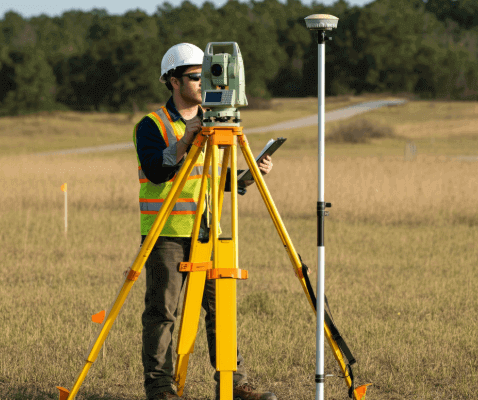It’s essential to know the precise boundaries of your property before building, installing a fence, or putting it up for sale. Studies show that a significant number of property disputes stem from unclear boundaries, which can lower the value of your land and lead to expensive legal problems. This guide breaks down the process of finding property lines on your land, helping you avoid headaches and make informed decisions. We will walk you through everything, from reading your deed and using digital maps to determining when to call in a professional surveyor. Steve Daria and Joleigh are experienced real estate investors and cash land buyers. They understand that clear boundaries are crucial for a smooth sale. Learning the steps for finding property lines on your land helps protect your investment and simplifies future projects or transactions. Want clarity and peace of mind about your property’s boundaries? Book a free discussion with Steve Daria and Joleigh today to get started.
Key Points
- Start with Your Property Deed and Plat Map: Your property’s deed and plat map are essential documents that outline boundary lines and measurements. These records provide a legal description of the land and can often be obtained through your local county recorder’s office.
- Use Physical Landmarks and Survey Markers: Look for iron pins, concrete markers, or stakes that a previous surveyor may have placed. While these help estimate property lines, erosion or landscaping changes might shift or hide them over time.
- Check County GIS or Online Mapping Tools: Many counties offer Geographic Information System (GIS) websites where you can view parcel boundaries. These maps give a general idea but may not be precise enough for legal purposes or building projects.
- Hire a Licensed Land Surveyor for Accuracy: If you need exact boundary lines—for fencing, selling, or building—hire a professional surveyor. They use specialized equipment and ensure your property lines are legally verified.
- Avoid Boundary Disputes with Clear Communication: If in doubt, discuss property lines with your neighbors before making changes. A simple conversation can prevent legal disputes and promote good neighborly relations.
What are property lines, and why do they matter?
Property lines are the official borders that mark where your property ends and your neighbor’s begins.
They are crucial because they protect your ownership rights and prevent you from accidentally building on someone else’s property.
Failing to determine your boundaries can lead to costly legal disputes, so it’s essential to rely on official documents, such as your property deed, a plat map, or a professional survey.

Understanding these boundaries is essential before installing a fence, adding an extension, or planting a large garden, as it ensures compliance with local setback rules.
The process of finding property lines on your land helps you avoid encroachments, which are when a structure or object illegally extends onto a neighbor’s property.
This simple verification step is also often required to obtain building permits from your local government.
Ultimately, confirming your property lines saves you significant time, money, and stress by preventing conflicts and ensuring your projects are built in the right place.
This knowledge empowers you to use your land with complete confidence and peace of mind.
Get Started: Get Your Cash Offer Below…
We are direct land buyers. There are no commissions or fees and no obligation whatsoever. Start below by sharing where your property is and where we can send your offer…
Can I find my property lines for free?
Yes, you can often start finding property lines on your land for free using several accessible methods.
Begin by reviewing your property deed and its legal description, as well as the plat map, which should have been included in your closing documents.
Many county assessor or recorder websites also offer free online GIS mapping tools that provide a helpful, though not legally binding, visual overlay of your property.
You can also carefully walk your property to look for existing physical markers, such as iron pins or concrete monuments, at the corners.
However, it’s essential to recognize that these free methods and consumer-grade GPS apps are intended for estimation purposes only and may not provide completely accurate results.
They are a great starting point for your own knowledge, but they are not a substitute for a professional survey.
For definitive boundaries required for building, installing a fence, or resolving a dispute, you will need to hire a licensed surveyor.
This professional service provides the legal precision that free methods cannot guarantee, protecting your investment.
How do I find the physical markers for my property corners?
- Check Your Property Survey: Start by reviewing your property survey or plat map. This official document displays the exact shape, size, and boundary lines of your land, making it easier to locate the corner markers.
- Look for Iron Pins or Metal Rods: Most property corners are marked with metal rods or iron pins that are driven vertically into the ground. These are often found slightly below the surface and are especially helpful when finding property lines on your land.
- Use a Metal Detector: Since corner markers can be buried by dirt, grass, or landscaping over time, using a metal detector can help you locate them. Move slowly and listen for a strong beep when scanning near the suspected corner points.
- Walk the Boundary Based on Survey Measurements: Use a tape measure and compass to walk the distances and angles described in your survey. This method is particularly effective for pinpointing your property’s boundaries when original markers are absent or obscured.
- Hire a Licensed Surveyor: When all else fails, or if you need legal proof of your property lines, hire a licensed land surveyor. They have the tools and expertise to find and mark corners accurately.

What information is in a property deed’s legal description?
A property deed’s legal description contains the precise information needed to identify and locate a parcel of land, serving as its unique fingerprint.
Unlike a street address, it uses official survey methods, such as “metes and bounds,” which describe boundaries using distances, directions, and a starting point.
Another common method is the “lot and block” system, which refers to a specific parcel on a recorded plat map within a subdivision.
For larger rural tracts, the description might use the rectangular survey system of township, range, and section numbers.
This text is the most critical tool for finding property lines on your land because it provides the exact data a surveyor uses.
It details bearings, distances between corners, and references to physical monuments or markers that define the boundary.
Understanding this description is essential for avoiding disputes, obtaining building permits, and ensuring any fences or structures are correctly placed.
Ultimately, it is the definitive legal document that establishes the dimensions and location of your property.
When is it absolutely necessary to hire a surveyor?
- Before Building or Adding Structures: If you plan to build a fence, shed, garage, or home addition, it’s essential to hire a surveyor first. They make sure you stay within your property boundaries and avoid building on someone else’s land.
- When You Can’t Locate Property Markers: If you’re having trouble finding property lines on your land, a licensed surveyor can help locate or replace the missing corner markers. This ensures you’re working with accurate and legal boundary points.
- During Property Line Disputes: If you and a neighbor disagree about where the property line is, a surveyor can give you an official answer. Their report is legally recognized and can help resolve the issue without further conflict.
- Before Buying or Selling Property: When finding property lines on your land is critical during a sale or purchase, a survey confirms exactly what is being bought or sold. It protects both parties from future boundary or title issues.
- When Dividing or Subdividing Land: If you plan to divide your land into smaller lots, a surveyor is legally required. They make sure each section is properly measured, documented, and recorded with the county.
What should I do after confirming my property lines?
Once your property lines are confirmed, the next essential step is to establish a permanent record of the results.
Securely store the official survey document with your property deed and plat map, and consider making digital copies for backup.
You can visibly but non-permanently mark the corners with flags or stakes for easy reference, but never move the legal markers themselves.
This is the perfect time to update any personal site plans you have for your property.
Before starting any projects, such as building or fencing, review this information to ensure your plans comply with all easements and local setback regulations.
A crucial part of finding property lines on your land is using that knowledge to prevent future issues.
Always remember to call 811 to have underground utility lines marked before you or any contractors begin digging.
Once you are ready to proceed with construction, share the survey results with your contractors so they are fully informed.
For expert guidance on how to navigate land regulations and plan your next steps, consider consulting with a local licensed surveyor or real estate professional.
**NOTICE: Please note that the content presented in this post is intended solely for informational and educational purposes. It should not be construed as legal or financial advice or relied upon as a replacement for consultation with a qualified attorney or CPA. For specific guidance on legal or financial matters, readers are encouraged to seek professional assistance from an attorney, CPA, or other appropriate professional regarding the subject matter.
